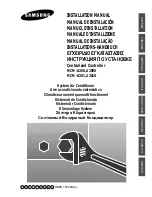
Unit Description
25
Electronic Throttling Valve
The Electronic Throttling Valve (ETV) is optional
on the Model SB-210 30 and standard on the
Models SB-210 50 and SB-310 30.
The Electronic Throttling Valve (ETV) is a
variable position valve operated by a stepper
motor. The ETV is located in the suction line
between the evaporator and the heat exchanger.
Discharge and suction pressure transducers supply
pressure information to the microprocessor
control system. The microprocessor controls the
electronic throttling valve directly. The ETV
replaces both the throttling valve and the
modulation valve used in other units. The ETV
system also uses a hot gas bypass valve like the
one used with the modulation valve in other units.
The ETV system provides enhanced control of the
refrigeration system as follows:
Suction Pressure Control:
The suction pressure
control algorithm is the primary control used to
obtain maximum capacity. This allows the
refrigeration system to fully utilize the power
capabilities of the engine under varying
conditions.
Discharge Pressure Protection:
This protection
algorithm provides an additional measure of
protection against high discharge pressures and
possible compressor damage. It will prevent
shutdowns in high ambient temperatures by
allowing continued operation of the unit at a
temporarily reduced refrigeration capacity.
Engine Coolant Temperature Protection:
This
protection algorithm protects the engine from high
coolant temperature shutdowns and possible
engine damage. It will reduce the load on the
engine by temporarily reducing refrigeration
capacity. This lowers the engine temperature
while still allowing continued unit operation.
Modulation Control:
The ETV system replaces the
modulation valve. The modulation control
algorithm operates much the same as modulation
on other units.
SMART REEFER 2 (SR-2) Control
System
The SR-2 is a microprocessor control system
designed for a transport refrigeration system. The
SR-2 integrates the following functions:
•
Changing setpoint and operating mode
•
Viewing gauge, sensor and hourmeter
readings
•
Initiating Defrost cycles
•
Viewing and clearing alarms.
The microprocessor components are located
inside the control box, which is located inside the
lower roadside service door. The microprocessor
is connected to an HMI (Human Machine
Interface) Control Panel. It is used to operate the
unit. The HMI control panel is mounted on the
face of the control box. It is clearly visible
through an opening in the lower roadside service
door.
See the Operating Instructions Chapter for more
information about the SR-2 controller.
CYCLE-SENTRY Start-Stop Controls
The CYCLE-SENTRY system automatically
starts the unit on microprocessor demand, and
shuts down the unit after those conditions are
satisfied.
The system automatically monitors and maintains
the compartment temperature, engine block
temperature, and battery charge levels at a
condition where quick, easy starts are possible.
WARNING: Do not operate the unit until
you are completely familiar with the
location and function of each control.
WARNING: Press the
O
FF
key on the HMI
control panel before opening doors or
inspecting any part of the unit. The unit
may start at any time without warning if it
has been turned on with the
O
N
key.
Summary of Contents for SB-210
Page 4: ...4 ...
Page 12: ...List of Figures 12 ...
Page 31: ...Unit Description 31 Unit Photos Figure 6 Front View AJA1617 ...
Page 36: ...Unit Description 36 ...
Page 49: ...Operating Instructions 49 Figure 32 Viewing Sensors Screen Sequence ...
Page 54: ...Operating Instructions 54 Figure 40 Datalogger Screen Sequence ...
Page 101: ...Engine Maintenance 101 ...
Page 102: ...Engine Maintenance 102 ...
Page 140: ...Electric Standby Diagnosis 140 ...
Page 150: ...Index 150 ...
Page 152: ...Wiring Diagram Index 152 ...
Page 153: ...153 Model 30 and 50 Schematic Diagram Page 1 of 3 ...
Page 154: ...154 Model 30 and 50 Schematic Diagram Page 2 of 3 ...
Page 155: ...155 Model 30 and 50 Schematic Diagram Page 3of 3 ...
Page 156: ...156 Model 30 and 50 Wiring Diagram Page 1 of 4 ...
Page 157: ...157 Model 30 and 50 Wiring Diagram Page 2 of 4 ...
Page 158: ...158 Model 30 and 50 Wiring Diagram Page 3 of 4 ...
Page 159: ...159 Model 30 and 50 Wiring Diagram Page 4 of 4 ...
















































